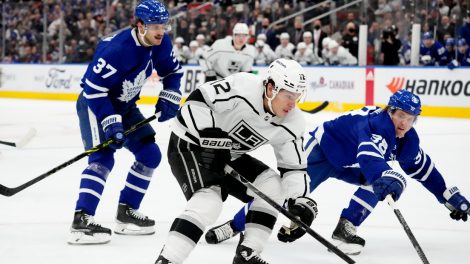TORONTO – Brad Marchand got a tap on the shoulder and he wasn’t the least bit happy about it.
The Team Canada forward was a couple minutes removed from a collision with Marian Hossa and the NHL’s new concussion protocol had kicked into effect. It was an independent spotter that got in touch with the trainers and had Marchand removed from Wednesday’s game for further evaluation, just as they did with Logan Couture earlier in the week against Team USA.
“I was very frustrated,” Marchand said Thursday. “Seven or eight minutes left in the game and you never know how long these things will take. Again, I understand it’s for my own safety, but you never like to leave a game. You want to be out there, especially, it was a 3-1 game at the time, a big time in that game.
“I want to be out there, but safety first.”
Marchand ended up passing his baseline test and returning late in the third period, but the situation highlighted what is expected to be an even stricter approach to head injuries this season.
As first reported by Sportsnet’s Elliotte Friedman earlier this month, the NHL now employs four independent trainers to monitor games remotely and look for visible signs of concussion. There will also continue to be team-affiliated spotters in every building.
The independent trainers will be given authority to have players removed from the game – just as Marchand was during the 4-1 win over Team Europe.
He said he felt fine after getting run over by Hossa on a collision where neither player seemed to see one another.
“It happened so quick,” said Marchand. “I didn’t see him coming, I didn’t know. I got absolutely buried.”
Fortunately, the Boston Bruins winger was feeling no ill effects a day later. He even cracked a joke about how things went during his baseline test: “They asked me my name, and I always mess that one up anyways.”
Concussion awareness has never been higher around the NHL.
Earlier in the year, Mike Babcock was asked about the Dennis Wideman situation – where the Flames defenceman was flagged by a spotter but refused to leave the game after running over linesman Don Henderson – and he said that as a coach you want your player to play if he feels OK.
However, Babcock acknowledged Thursday that he’s changed his tune.
“We’ve just got to smarten up and look straight ahead and not show that we have any kind of reaction (when a player is removed) even when we think it’s not worth it,” he said. “What we’re trying to do, and player safety, is look after the players. So it’s imperative we handle that in the right way.
“Do I think sometimes it’s needless and foolish? One hundred per cent. But I think with all rules there’s an intent to the rule and sometimes it probably doesn’t work out the way you want it, but that’s life.”
Despite his feelings in the moment, Marchand seemed to understand as well.
“I think they’re just being a little more cautious this year,” he said. “When there’s any kind of hit where the guy looks a little woozy then I think they’re going to look into it a little bit more and just be sure. Everything is extremely serious with the head contact right now and I think they just want to get ahead of it.
“It can be frustrating at times as a player, but you understand why it’s there.”








